“Kumbh Mela is a mass Hindu pilgrimage in which Hindus gather at the Ganges river. The normal Kumbh Mela is celebrated every 3 years, the Ardh (half) Kumbh Mela is celebrated every six years at Haridwar and Prayag, the Purna (complete) Kumbh takes place every twelve years, at four places (Prayag (Allahabad), Haridwar, Ujjain, and Nashik). The Maha (great) Kumbh Mela which comes after 12 “Purna Kumbh Melas”, or 144 years, is held at Allahabad.
The last Ardh Kumbh Mela was held over a period of 45 days beginning in January 2007, more than 70 million Hindu pilgrims took part in the Ardh Kumbh Mela at Prayag, and on January 15, the most auspicious day of the festival of Makar Sankranti, more than 5 million participated. The previous Maha Kumbh Mela, held in 2001, was attended by around 60 million people, making it at the time the largest gathering anywhere in the world in recorded history.
The first written evidence of the Kumbha Mela can be found in the accounts of Chinese traveler, Huan Tsang or Xuanzang (602 – 664 A.D.) who visited India in 629 – 645 CE, during the reign of King Harshavardhana. However, the observance dates back many centuries to ancient India's Vedic period, where the river festivals first started getting organised. In Hindu mythology, its origin is found in one of the popular creation myths, the Samudra manthan episode (Churning of the ocean of milk), mentioned in the Bhagavata Purana, Vishnu Purana, the Mahabharata, and the Ramayana.
The account goes that the Gods had lost their strength, and to regain it, they thought of churning the Ksheera Sagara (primordial ocean of milk) for amrita (the nectar of immortality). This required them to make a temporary agreement with their arch enemies, the demons or Asuras, to work together with a promise of sharing the nectar equally thereafter. However, when the Kumbha (urn) containing the amrita appeared, a fight ensued. For twelve days and twelve nights (equivalent to twelve human years) the gods and demons fought in the sky for the pot of amrita. It is believed that during the battle, Lord Vishnu flew away with the Kumbha of elixir spilling drops of amrita at four places: Prayag, Haridwar, Ujjain and Nashik.
The major event of the festival is ritual bathing at the banks of the river in whichever town it is being held. Nasik has registered maximum visitors amounted nearly to 75 million. Other activities include religious discussions, devotional singing, mass feeding of holy men and women and the poor, and religious assemblies where doctrines are debated and standardized. Kumbh Mela is the most sacred of all the pilgrimages. Thousands of holy men and women attend, and the auspiciousness of the festival is in part attributable to this. The sadhus are seen clad in saffron sheets with ashes and powder dabbed on their skin per the requirements of ancient traditions. Some, called naga sanyasis, may not wear any clothes even in severe winter.
After visiting the Kumbh Mela of 1895, Mark Twain wrote: «It is wonderful, the power of a faith like that, that can make multitudes upon multitudes of the old and weak and the young and frail enter without hesitation or complaint upon such incredible journeys and endure the resultant miseries without repining. It is done in love, or it is done in fear; I do not know which it is. No matter what the impulse is, the act born of it is beyond imagination, marvelous to our kind of people, the cold whites»”. – Wikipedia
The last Ardh Kumbh Mela was held over a period of 45 days beginning in January 2007, more than 70 million Hindu pilgrims took part in the Ardh Kumbh Mela at Prayag, and on January 15, the most auspicious day of the festival of Makar Sankranti, more than 5 million participated. The previous Maha Kumbh Mela, held in 2001, was attended by around 60 million people, making it at the time the largest gathering anywhere in the world in recorded history.
The first written evidence of the Kumbha Mela can be found in the accounts of Chinese traveler, Huan Tsang or Xuanzang (602 – 664 A.D.) who visited India in 629 – 645 CE, during the reign of King Harshavardhana. However, the observance dates back many centuries to ancient India's Vedic period, where the river festivals first started getting organised. In Hindu mythology, its origin is found in one of the popular creation myths, the Samudra manthan episode (Churning of the ocean of milk), mentioned in the Bhagavata Purana, Vishnu Purana, the Mahabharata, and the Ramayana.
The account goes that the Gods had lost their strength, and to regain it, they thought of churning the Ksheera Sagara (primordial ocean of milk) for amrita (the nectar of immortality). This required them to make a temporary agreement with their arch enemies, the demons or Asuras, to work together with a promise of sharing the nectar equally thereafter. However, when the Kumbha (urn) containing the amrita appeared, a fight ensued. For twelve days and twelve nights (equivalent to twelve human years) the gods and demons fought in the sky for the pot of amrita. It is believed that during the battle, Lord Vishnu flew away with the Kumbha of elixir spilling drops of amrita at four places: Prayag, Haridwar, Ujjain and Nashik.
The major event of the festival is ritual bathing at the banks of the river in whichever town it is being held. Nasik has registered maximum visitors amounted nearly to 75 million. Other activities include religious discussions, devotional singing, mass feeding of holy men and women and the poor, and religious assemblies where doctrines are debated and standardized. Kumbh Mela is the most sacred of all the pilgrimages. Thousands of holy men and women attend, and the auspiciousness of the festival is in part attributable to this. The sadhus are seen clad in saffron sheets with ashes and powder dabbed on their skin per the requirements of ancient traditions. Some, called naga sanyasis, may not wear any clothes even in severe winter.
After visiting the Kumbh Mela of 1895, Mark Twain wrote: «It is wonderful, the power of a faith like that, that can make multitudes upon multitudes of the old and weak and the young and frail enter without hesitation or complaint upon such incredible journeys and endure the resultant miseries without repining. It is done in love, or it is done in fear; I do not know which it is. No matter what the impulse is, the act born of it is beyond imagination, marvelous to our kind of people, the cold whites»”. – Wikipedia
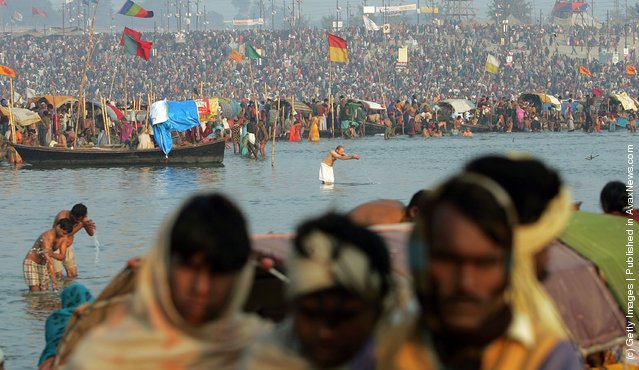
Pilgrims bathe at the ritual bathing site at Sangam, the confluence of the Ganges, Yamuna and mythical Saraswati rivers during the Ardh Kumbh Mela festival (Half Pitcher festival) January 18, 2007 in Allahabad, India. The water is heavily polluted and many Sadhus (holy men) have threatened to boycott the bathing due to the pollution. Millions of Hindu pilgrims have flocked to the largest religious gathering in the world which lasts for 45 days in northern India. The festival commemorates the mythical conflict between gods and demons over a pitcher filled with the “nectar of immortality”. Devotees believe that taking a holy dip in the Ganges at this time washes away their sins and paves the path to salvation. (Photo by Mario Tama/Getty Images)

Sadhus (holy men) smoke at their camp near the ritual site at Sangam, the confluence of the Ganges, Yamuna and mythical Saraswati rivers during the Ardh Kumbh Mela festival (Half Pitcher festival) January 18, 2007 in Allahabad, India. (Photo by Mario Tama/Getty Images)
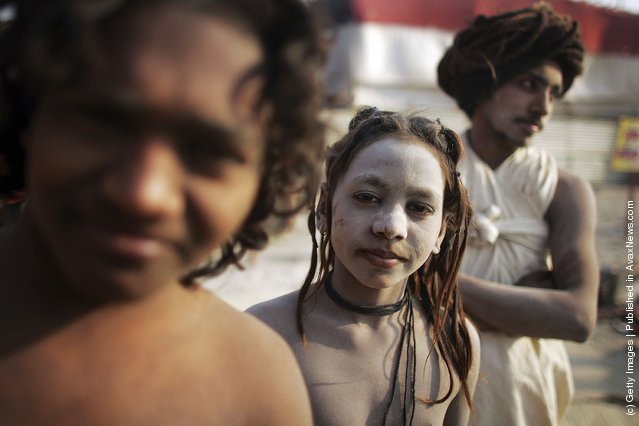
Young HIndu pilgrims gather near the ritual site at Sangam, the confluence of the Ganges, Yamuna and mythical Saraswati rivers during the Ardh Kumbh Mela festival (Half Pitcher festival) January 18, 2007 in Allahabad, India. (Photo by Mario Tama/Getty Images)
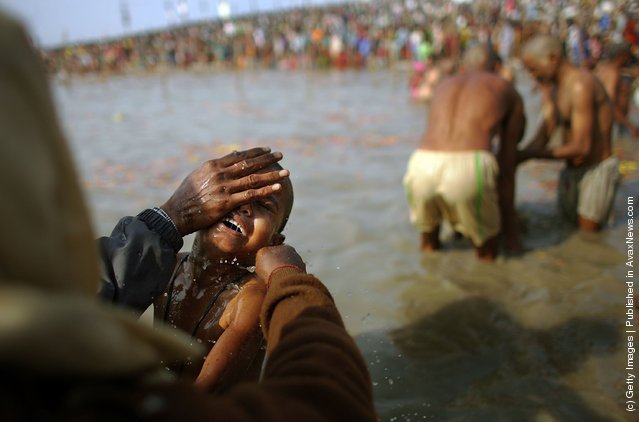
A Hindu pilgrim bathes his son as others gather at the ritual bathing site at Sangam, the confluence of the Ganges, Yamuna and mythical Saraswati rivers during the Ardh Kumbh Mela festival (Half Pitcher festival) January 19, 2007 in Allahabad, India. (Photo by Mario Tama/Getty Images)
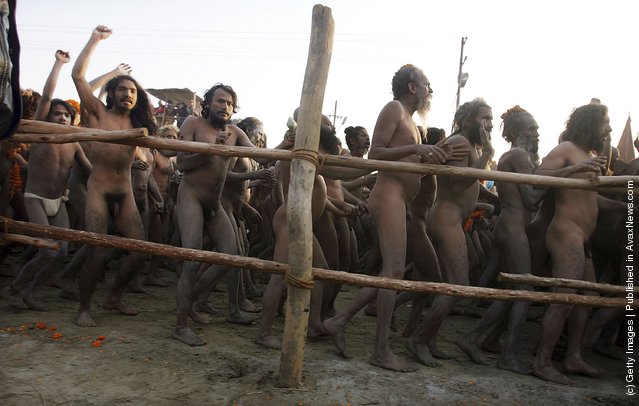
Hindu Naga Sadhus (holy men) make their way to the ritual bathing site at Sangam, the confluence of the Ganges, Yamuna and mythical Saraswati rivers during the Ardh Kumbh Mela festival (Half Pitcher festival) January 19, 2007 in Allahabad, India. (Photo by Mario Tama/Getty Images)

Hindu pilgrims watch a child dressed as the Hindu god Shiva near the ritual bathing site at Sangam, the confluence of the Ganges, Yamuna and mythical Saraswati rivers during the Ardh Kumbh Mela festival (Half Pitcher festival) January 20, 2007 in Allahabad, India. (Photo by Mario Tama/Getty Images)
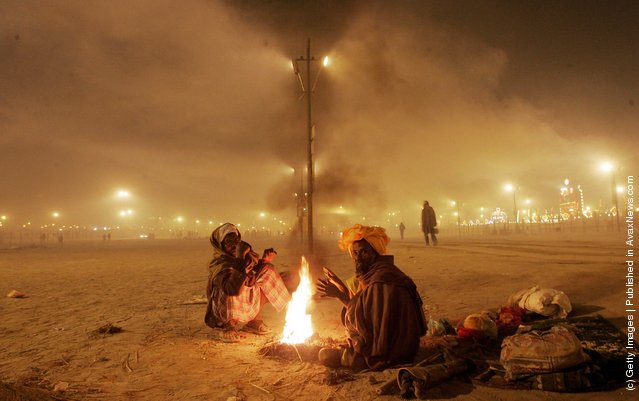
Poor Hindu pilgrims sit by a fire beneath a cloud of disinfectant sprayed nightly from trucks near the ritual bathing site at Sangam, the confluence of the Ganges, Yamuna and mythical Saraswati rivers during the Ardh Kumbh Mela festival (Half Pitcher festival) January 20, 2007 in Allahabad, India. (Photo by Mario Tama/Getty Images)
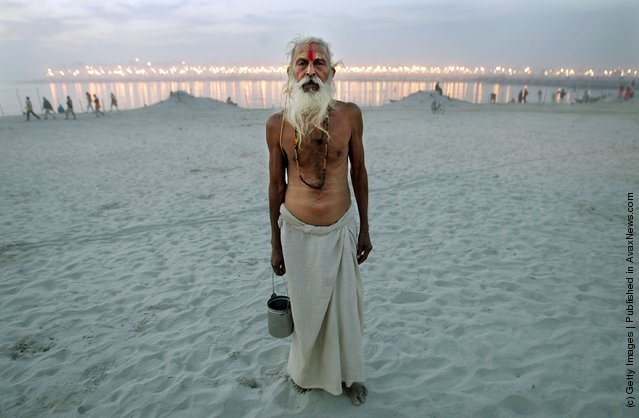
A Hindu Sadhu stands at dusk at the ritual bathing site at Sangam, the confluence of the Ganges, Yamuna and mythical Saraswati rivers during the Ardh Kumbh Mela festival (Half Pitcher festival) January 20, 2007 in Allahabad, India. (Photo by Mario Tama/Getty Images)
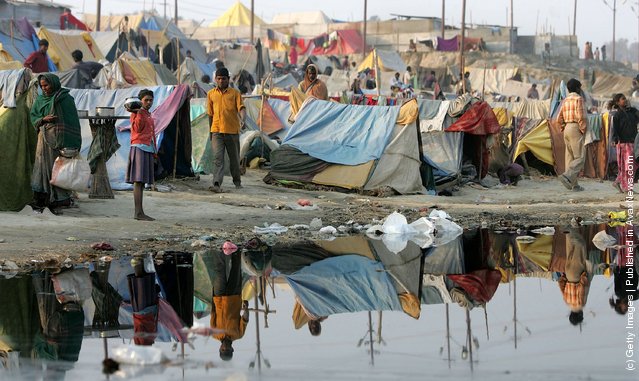
Poor Hindu pilgrims stand at their makeshift campsite at the ritual bathing site at Sangam, the confluence of the Ganges, Yamuna and mythical Saraswati rivers during the Ardh Kumbh Mela festival (Half Pitcher festival) January 21, 2007 in Allahabad, India. (Photo by Mario Tama/Getty Images)

Hindu Sadhus (holy men) sleep at their campsite near the ritual bathing site at Sangam, the confluence of the Ganges, Yamuna and mythical Saraswati rivers during the Ardh Kumbh Mela festival (Half Pitcher festival) January 21, 2007 in Allahabad, India. (Photo by Mario Tama/Getty Images)
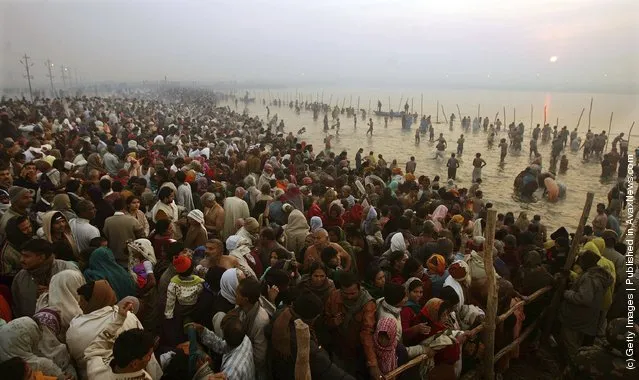
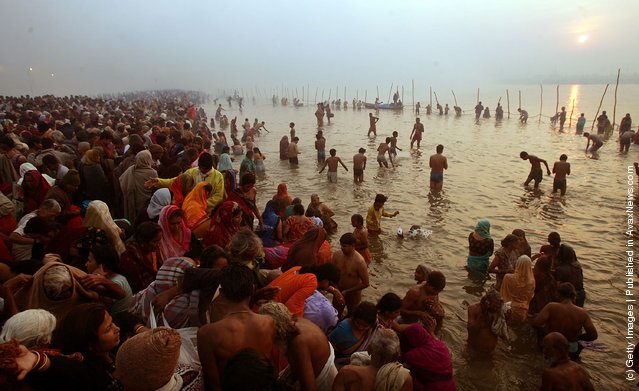

Hindu pilgrims bathe at the ritual bathing site at Sangam, the confluence of the Ganges, Yamuna and mythical Saraswati rivers during the Ardh Kumbh Mela festival (Half Pitcher festival) January 23, 2007 in Allahabad, India. (Photo by Mario Tama/Getty Images)
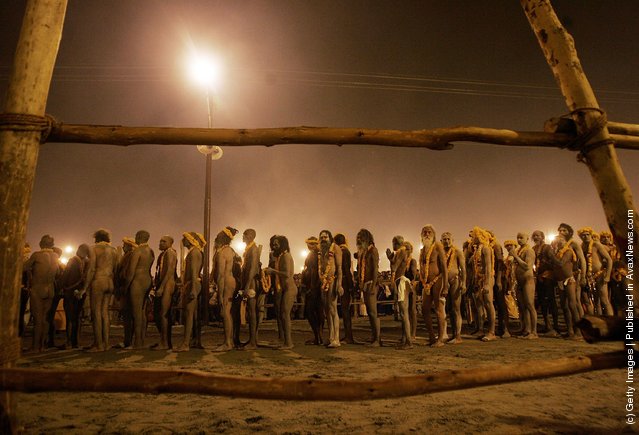
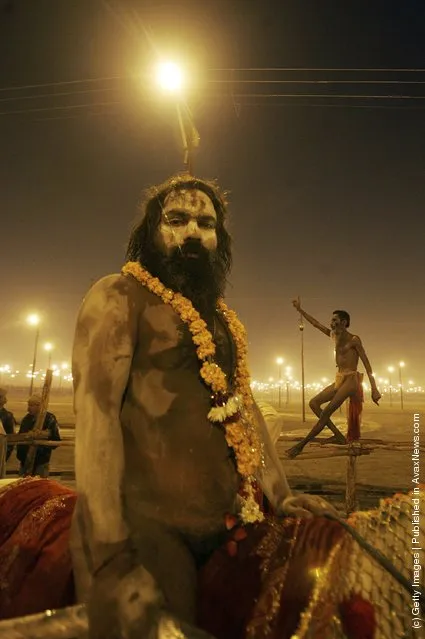
Hindu Sadhus (holy men) gather to bathe before sunrise at the ritual bathing site at Sangam, the confluence of the Ganges, Yamuna and mythical Saraswati rivers during the Ardh Kumbh Mela festival (Half Pitcher festival) January 23, 2007 in Allahabad, India. (Photo by Mario Tama/Getty Images)
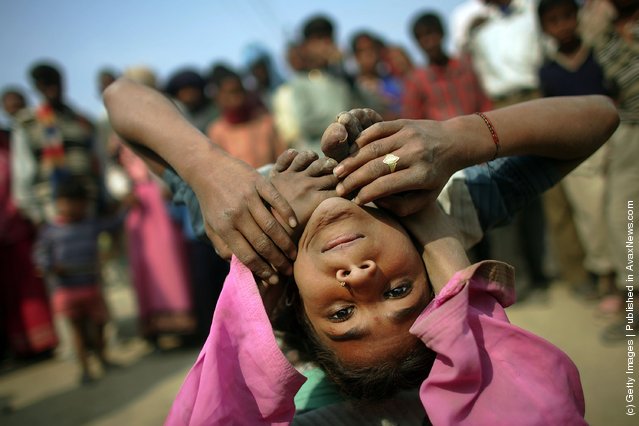
A girl performs as a contortionist for handouts for Hindu pilgrims near the ritual bathing site at Sangam, the confluence of the Ganges, Yamuna and mythical Saraswati rivers during the Ardh Kumbh Mela festival (Half Pitcher festival) January 24, 2007 in Allahabad, India. Tens of millions of Hindu pilgrims have already attended the 45 day festival in northern India which is the largest religious gathering in the world. (Photo by Mario Tama/Getty Images)
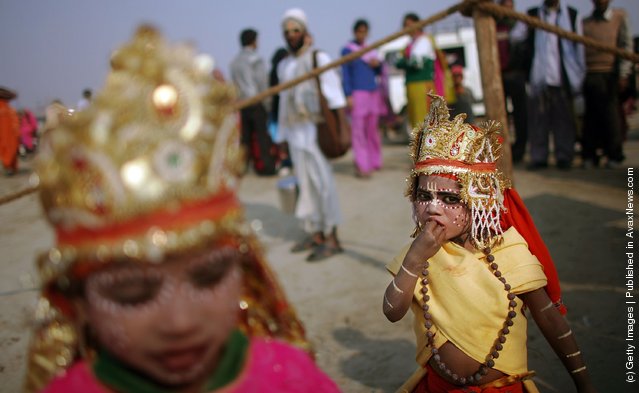
Girls are dressed as goddesses as they wait for handouts from Hindu pilgrims near the ritual bathing site at Sangam, the confluence of the Ganges, Yamuna and mythical Saraswati rivers during the Ardh Kumbh Mela festival (Half Pitcher festival) January 24, 2007 in Allahabad, India. (Photo by Mario Tama/Getty Images)
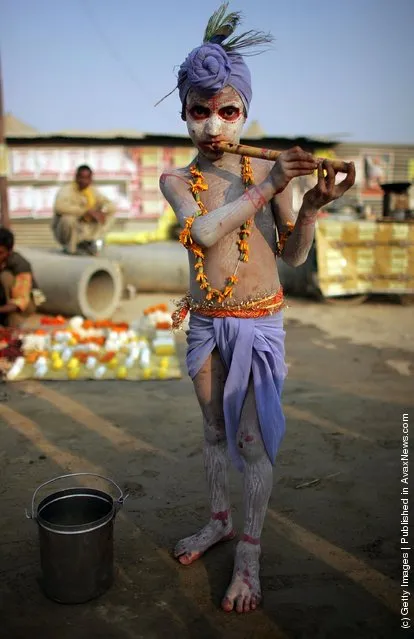
A child plays a flute for handouts near the ritual bathing site at Sangam, the confluence of the Ganges, Yamuna and mythical Saraswati rivers during the Ardh Kumbh Mela festival (Half Pitcher festival) January 24, 2007 in Allahabad, India. (Photo by Mario Tama/Getty Images)
30 Jun 2011 10:27:00,
post received
0 comments
